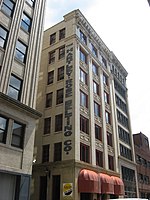Braddock Expedition

The Braddock expedition, also called Braddock's campaign or (more commonly) Braddock's Defeat, a failed British military expedition, attempted to capture the French Fort Duquesne (established in 1754, located in what is now downtown Pittsburgh) in the summer of 1755, during the French and Indian War of 1754 to 1763. The British troops suffered defeat at the Battle of the Monongahela on July 9, 1755, and the survivors retreated. The expedition takes its name from General Edward Braddock (1695–1755), who led the British forces and died in the effort. Braddock's defeat was a major setback for the British in the early stages of the war with France; John Mack Faragher characterises it as one of the most disastrous defeats for the British in the 18th century.
Excerpt from the Wikipedia article Braddock Expedition (License: CC BY-SA 3.0, Authors, Images).Braddock Expedition
Station Square Trail, Pittsburgh
Geographical coordinates (GPS) Address Nearby Places Show on map
Geographical coordinates (GPS)
| Latitude | Longitude |
|---|---|
| N 40.433333333333 ° | E -80 ° |
Address
Station Square Trail
Station Square Trail
15282 Pittsburgh
Pennsylvania, United States
Open on Google Maps










